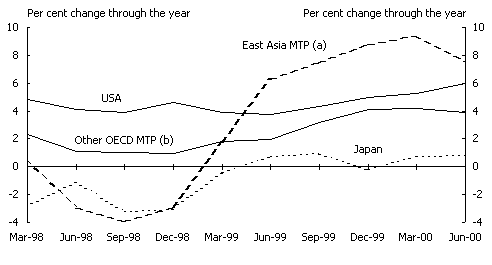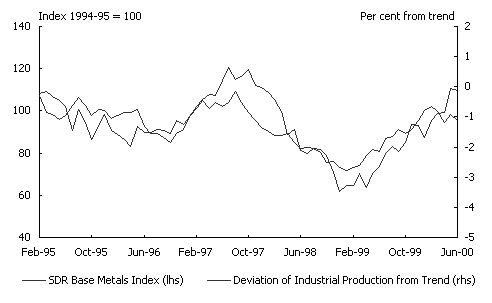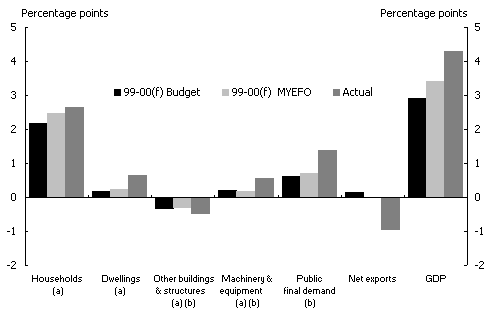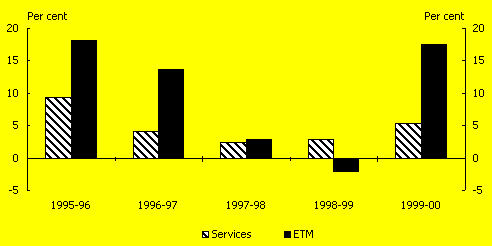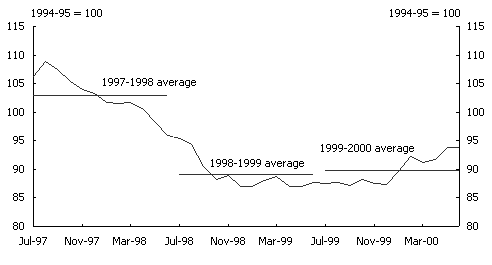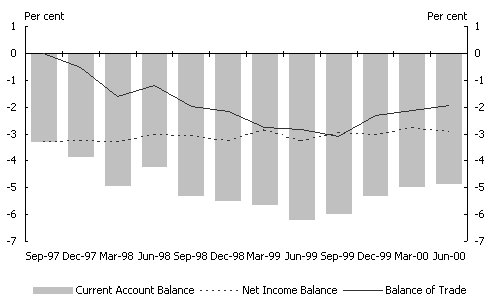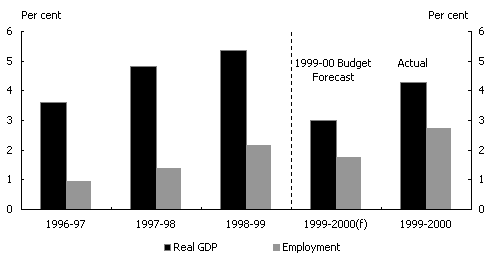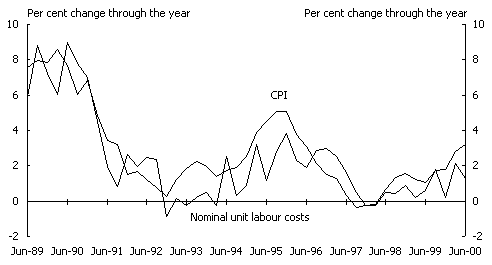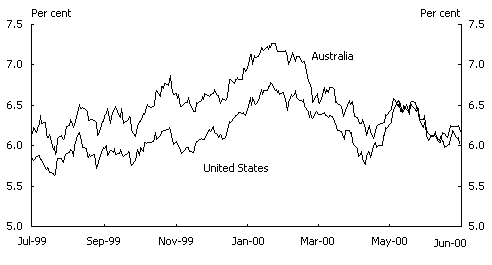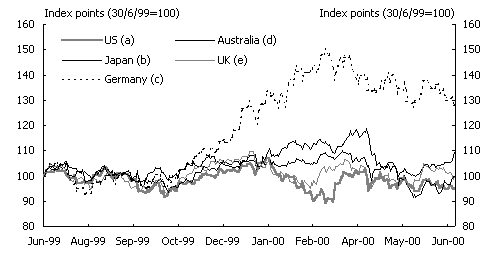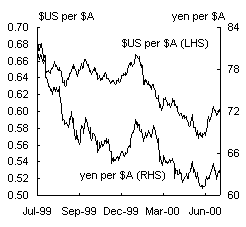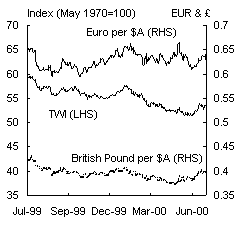|
The Australian economy continued to grow very strongly in 1999-2000, significantly exceeding expectations. A bring forward of activity, particularly household consumption and housing construction, ahead of the introduction of The New Tax System appears to have contributed to this strong growth, as did a strengthening world economy. Strong growth underpinned, and was supported by, solid employment growth and falling unemployment. Inflation increased slightly in 1999-2000, largely reflecting higher world oil prices. The outstanding performance of the Australian economy has been the outcome of a sound macroeconomic policy framework that has delivered sustained low inflation and solid fiscal surpluses, coupled with an ongoing reform agenda that has helped deliver higher productivity growth and a more responsive, competitive and flexible economy. |
||||
|
The Australian economy performed remarkably well in 1999-2000, |
Overview of the economy in 1999-2000The Australian economy grew by a strong 4.3 per cent in year-average terms in 1999-2000, well above earlier expectations, building on the very strong growth of 4.8 per cent in 1997-98 and 5.4 per cent in 1998-99. The 1999-2000 outcome was the ninth year of continuous growth, with the growth rate over the period averaging 3.9 per cent per annum. Growth through the year to the June quarter 2000 was 4.7 per cent. This was the thirteenth consecutive quarter of through-the-year growth of 4 per cent or above, an outcome unprecedented in the history of the Quarterly National Accounts (compiled since 1959). The strong growth in 1999-2000 reflected rapid growth in both private and public sector demand. Some of the strength in private sector demand, particularly household consumption and residential construction, is likely to have reflected a bring forward of spending into 1999-2000, ahead of the introduction of The New Tax System. In addition, the strengthening world economy supported growth in the Australian economy through a boost to exports, commodity prices and the terms of trade. Strong growth has underpinned continued employment growth and falling unemployment. Employment increased by 2.7 per cent in 1999-2000, enabling the unemployment rate to fall to 6.6 per cent in June 2000 - its lowest level in a decade. Unlike past expansions, the strong economic growth, rising employment and declining unemployment were achieved with ongoing inflation and wage pressures remaining subdued. |
|||
|
reflecting a sound mix of economic policy. |
The strong performance of the Australian economy is a testament to the sound macroeconomic policy framework and an economy made more flexible and resilient through an ongoing microeconomic reform agenda. |
|||
|
Fiscal consolidation continued, |
During 1999-2000, the Government built on the fiscal consolidation of the previous three years, consistent with its objective of achieving fiscal balance, on average, over the course of the economic cycle. The Commonwealth general government sector achieved an underlying cash surplus of $12.7 billion (2 per cent of GDP) in 1999-2000, up from $4.2 billion (0.7 per cent of GDP) in 1998-99. As a proportion of GDP, this is the largest surplus since 1971-72, providing a substantial contribution to national savings. The fiscal surplus was $13.5 billion (2.1 per cent of GDP) in 1999-2000. The underlying cash surplus, together with receipts from asset sales, allowed Commonwealth general government net debt to be further reduced from 11.9 per cent of GDP in 1998-99 to 8.4 per cent of GDP in 1999-2000. |
|||
|
and monetary policy was tightened relative to earlier settings. |
Over the course of 1999-2000, beginning in November 1999, the Reserve Bank of Australia (RBA) increased official interest rates on four separate occasions by a total of 125 basis points, to 6 per cent. This mirrored policy tightening in most major economies1. |
|||
|
World growth picked up in 1999, |
International economyThe world economy grew by 3.3 per cent in 1999, up from 2.5 per cent in 1998 (purchasing power parity weights) and significantly above the 1999-2000 Budget and Mid-Year Economic and Fiscal Outlook (MYEFO) forecasts2. World growth continued to strengthen into 2000. |
|||
|
largely due to strong growth in the US and a rebound in non-Japan East Asia, |
The pick up in world growth was largely driven by strong growth in the United States (US), aided by strengthening growth in Europe, and a strong rebound in growth in non-Japan East Asia. Japan recovered from a contraction in growth in 1998 to record positive although low growth in 1999 and into 2000 (see Chart 1). |
|||
|
World growth in 1999 and the first half of 2000 was stronger than expected because growth in the US did not ease as anticipated, and because the rebound in non-Japan East Asia was stronger and occurred earlier than predicted at the time of the 1999-2000 Budget and the 1999-2000 MYEFO. By the beginning of 2000, the US was experiencing its longest economic expansion on record. It was expected that growth would slow over 1999-2000, however, strong productivity growth, moderate wage increases and a rising US dollar saw inflation remain low (albeit increasing slightly) and the high rates of growth sustained. Consequently, the Budget forecasts for world growth in 1999 and 2000 were revised up significantly in the MYEFO. In the second half of 1999, many private sector analysts and international institutions also revised their outlook for growth in 1999 and 2000: including upgrading US forecasts by up to 1 percentage point, and world growth forecasts by up to of a percentage point. Even then, the growth outcomes for 1999 and into 2000 surprised on the upside. Further detail on developments in Australia's major trading partners is provided in Box 1. |
||||
|
Chart 1: Real GDP growth in |
||||
|
weighted by merchandise exports. (b) Germany, France, United Kingdom, Italy, Canada and New Zealand weighted by merchandise exports. |
||||
|
resulting in stronger commodity prices, |
Stronge |
|||
|
When world industrial production is above its trend level, base metal prices tend to rise and vice versa (see Chart 2). |
||||
|
Chart 2: Base metal prices and OECD industrial production |
||||
|
|
||||
|
and monetary policy tightening in a number of countries. |
Improving world growth and tightness in product and labour markets saw an increase in inflationary pressures in a number of countries in 1999-2000, including the US, Europe and New Zealand. In response, the central banks of these economies began tightening monetary policy. Inflationary pressure in Asia was subdued. |
|||
Table 1: 1999-2000 Budget and MYEFO forecasts and outcomes
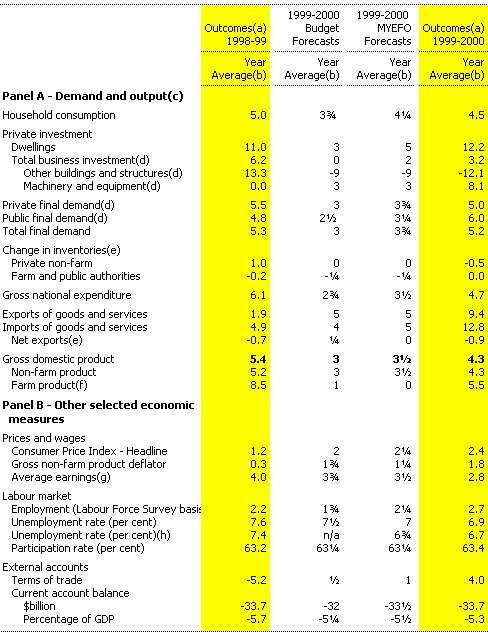
- (a) Calculated using original data, except average earnings and the labour market measures which are calculated using seasonally adjusted data.
(b) Percentage change on preceding year unless otherwise indicated.
(c) Chain volume measure.
(d) Excluding transfers of net second-hand asset sales from the public sector to the private sector.
(e) Percentage point contribution to growth in GDP.
(f) Calculated at basic prices.
(g) Average non-farm compensation of employees (national accounts basis).
(h) The level in the June quarter of each year.
|
Growth was expected to moderate in 1999-2000, |
Domestic demandIn compiling the Budget forecasts for 1999-2000, some moderation in growth was expected from the very strong rates recorded in the two previous years. The sustained period of strong growth had resulted in a significant reduction in unemployment and was judged to have reduced the degree of spare capacity in the economy more generally. At the same time, international growth, while On the demand side of the economy, household consumption growth was expected to moderate; private non-residential construction was predicted to decline from earlier high levels; dwelling investment was forecast to be relatively stable; and public demand was anticipated to ease. Partially offsetting influences were expected to be a pick-up in both export growth and plant and equipment investment as the international economy strengthened gradually. |
||||
|
but exceeded expectations; |
The economic growth forecast for 1999-2000 was revised up at MYEFO to reflect a more optimistic world growth outlook as well as evidence of stronger than expected growth in domestic demand in the early part of the year, particularly household consumption, and strong growth in employment. |
||||
|
with domestic demand much stronger than forecast. |
In the event, most components of demand grew even more strongly than expected at MYEFO (see Chart 3). Some of this extra domestic spending spilled over onto imports so that net exports detracted from growth, despite solid growth in export volumes. |
||||
|
Chart 3: Contributions to GDP growth 1999-2000 |
|||||
|
(b) Excluding transfers of net second-hand asset sales from the public sector to the private sector. |
|||||
|
Household consumption grew strongly, |
Household consumption was expected to make a solid contribution to GDP growth in 1999-2000, underpinned by a small bring forward of consumption ahead of the introduction of The New Tax System. However, growth in consumption was stronger than expected (albeit only slightly, compared to the MYEFO forecasts), largely the result of higher than expected employment growth and very strong growth in real private sector wealth, which grew by more than 10 per cent3 in 1999-2000 (up from around 7 per cent in 1998-99), and the strongest increase since 1988-89. |
||||
|
dwelling investment exceeded expectations, |
Growth in dwellings investment in 1999-2000 was significantly stronger than the Budget and MYEFO forecasts, mainly the result of a larger than expected bring-forward of activity ahead of The New Tax System. In the lead-up to the implementation of The New Tax System, dwelling investment grew by 10 per cent in the June quarter 2000, the strongest quarterly growth since March 1976. |
||||
|
as did investment in machinery and equipment |
Investment in `new' machinery and equipment4 in 1999-2000 exceeded the Budget and MYEFO forecasts. Buoyant conditions in the domestic economy and strengthening growth in manufacturing exports, especially in the first half of the year, contributed to high rates of capacity utilisation and healthy corporate profitability - both of which were conducive to increased levels of machinery and equipment investment. |
||||
|
and public final demand. |
The stronger growth in public final demand in 1999-2000 was largely attributable to additional Commonwealth expenditure associated with increased East Timor related expenditure on defence. Strong public trading enterprises investment (particularly by Telstra) more than offset the moderation in expenditure by State and local governments. |
||||
|
Net exports detracted from growth in 1999-2000. |
External sectorNet Exports detracted 0.9 of a percentage point from economic growth in 1999-2000. This contrasts with the Budget forecast of a of a percentage point contribution and the MYEFO forecast of no contribution to growth. The key difference relative to earlier forecasts was much stronger growth in imports, more than offsetting the impact of the stronger world economy on exports. |
||||
|
Export growth was strong, |
Export volumes of goods and services grew by 9.4 per cent in 1999-2000, much stronger than the Budget and MYEFO forecasts. Export growth rebounded to around pre-Asian crisis levels, up from around only 2 per cent in 1998-99 and around 4 per cent in 1997-98, reflecting the recovery in Asia, strong overall world growth and a lower Australian dollar. Export growth was broadly based in 1999-2000, with the key to the rebound in export volumes being the recovery in elaborately transformed manufactures (ETM) and services (see Box 2). |
||||
|
but import growth was stronger, |
At the same time, imports also increased very rapidly in 1999-2000, rising almost 13 per cent, well above both the Budget and the MYEFO forecasts. Goods imports rose around 14 per cent, while services were up around 8 per cent. |
||||
|
as a result of stronger domestic demand, |
This strong growth in imports largely reflected higher than expected growth in domestic final demand, particularly investment in machinery and equipment, a component of domestic demand that is more heavily weighted towards imports. For example, the volume of imports of automatic data processing equipment increased by almost 40 per cent and the volume of imports of telecommunication equipment increased by more than 50 per cent. |
||||
|
and one-off imports. |
The strength in imports also reflected a significant rise in one-off imports, with civil aircraft increasing by around $770 million or almost 120 per cent and goods for processing (predominantly gold for processing and re-export) up about $1.2 billion or almost 70 per cent. |
||||
|
Box 2: Export growth ETM and services exports are both very sensitive to economic conditions in the importing country. With Asia being an important destination for Australian ETM and services exports, the Asian crisis had a significant effect on Australia's exports of these goods and services, as they are more difficult to divert to other markets (compared to commodity exports). With the faster than expected recovery in Asia, both sectors rebounded in 1999-2000. The volume of ETM exports rose 17.5 per cent in 1999-2000, a major turnaround from a 2 per Chart 4: Australia's export volumes growth
Rural export volumes grew by 10.6 per cent in 1999-2000 following solid growth of 7.0 per cent in 1998-99. The growth in 1999-2000 was underpinned by record production of wheat and canola, reflecting above average seasonal conditions coupled with an increase in the area planted. Wool exports strengthened with a rundown in stocks, and dairy exports increased reflecting rising production and the strong recovery in key Asian markets. Non-rural commodity export volumes grew by around 3 per cent in 1999-2000, supported by increased production capacity in metal ores and metal refineries and new oil projects coming on line. The volume of iron ore exports increased by more than 10 per cent, reflecting stronger steel production in Japan. |
|||||
|
The terms of trade improved, |
The terms of trade had fallen markedly in 1998-99, reflecting the effects of the Asian crisis. Much of that fall was reversed in 1999-2000 with the terms of trade rising by 4 per cent, significantly more than the Budget and MYEFO forecast. |
||||
|
as export prices rose, |
Export prices recovered significantly in 1999-2000, rising 2.8 per cent following a 3.5 per cent decline in the previous year. This turnaround partly reflected a pick up in commodity prices on world markets, in conjunction with a lower exchange rate. Commodity prices in (currency neutral) Special Drawing Rights (SDR) terms - as measured by the RBA Commodity Price Index - rose 0.8 per cent in 1999-2000, following declines of 13.4 per cent in 1998-99 and 2.8 per cent in 1997-98 (see Chart 5). |
||||
|
Chart 5: RBA commodity price index (SDR terms) |
|||||
|
|
|||||
|
|
Despite the fall in the Australian dollar, import prices declined 1.2 per cent over the year, following a rise of 1.7 per cent in 1998-99. Import prices of both goods and services declined in 1999-2000 with goods prices falling more rapidly than those of services. Goods prices were down 1.4 per cent while services prices fell 0.4 per cent. The fall in imported goods prices was broadly based, suggesting that strong global competition helped to keep prices subdued. |
||||
|
leading to a fall in the CAD. |
Supported by the rebound in the terms of trade, the current account deficit (CAD) fell to 5.3 per cent of GDP in 1999-2000, from 5.7 per cent in the previous year, while remaining at $33.7 billion in dollar terms (see Chart 6). |
||||
|
Chart 6: Australia's current account balance as a share of GDP |
|||||
|
|
|||||
|
Employment growth exceeded the forecast; |
Labour marketIn 1999-2000, employment increased by a strong 2.7 per cent in year-average terms, well above the Budget and MYEFO forecast. Average employment in 1999-2000 was around 236 000 higher than in 1998-99 and around 80 000 higher than forecast at Budget. |
||||
|
as did the fall in unemployment, |
The strong increase in employment helped underpin the continued decline in the number of unemployed. The unemployment rate averaged 6.9 per cent in year-average terms in 1999-2000, down from 7.6 per cent in 1998-99. The unemployment rate declined to 6.7 per cent in the June quarter 2000, the lowest level in a decade, and well below the Budget forecast of 7 per cent. |
||||
|
underpinned by strong growth and a well functioning labour market. |
The stronger than expected labour market outcomes both reflected, and helped to facilitate, the continuing very strong economic growth (see Chart 7). With a well functioning, more flexible labour market, much of the rapid growth in domestic spending on goods and services was able to be met by increased production and employment at home, without the bottlenecks and wage and price pressures which had characterised earlier economic upswings. Strong growth in production and employment, and falling unemployment, in turn helped to boost household incomes and wealth, thus supporting strong growth in spending. |
||||
|
Chart 7: Strong economic growth underpins employment growth |
|||||
|
|
|||||
|
Employment was strong in industries recording strong growth. |
At the broader industry level, pre-GST related housing construction and the completion of Olympics-related building projects resulted in strong employment growth in the construction sector. Strong growth in household consumption more generally, in addition to pre-GST related purchases of goods and services, are likely to have supported solid employment growth across a number of industries, particularly in the Retail Trade and Property and Business Services sectors. Towards the end of the financial year, employment in Property and Business Services may have also benefited from businesses' preparation for the introduction of The New Tax System. In contrast, employment in the Mining sector declined for the third successive year in line with subdued investment in that sector and ongoing industry rationalisation. |
||||
|
The benefits of employment growth were shared; |
The benefits of strong growth in employment and falling unemployment were shared widely across the community in 1999-2000. Long term unemployment and teenage unemployment both fell significantly, while employment increased strongly and unemployment fell in many re |
||||
|
the number of long-term unemployed declined, |
In 1999-2000, the average number of long-term unemployed declined to around 190 000 (or 29 per cent of the total number of unemployed), from 230 000 in 1998-99. This was the lowest number of long-term unemployed and also the lowest proportion of long-term unemployed to total unemployment in almost a decade. |
||||
|
and the teenage unemployment rate fell. |
Employment amongst 15-19 year olds increased strongly over the year. While this also had the effect of encouraging higher participation in the labour force among teenagers (to its highest level in a decade), the year average teenage unemployment rate declined to a decade low of 17.8 per cent, compared with its historical peak of 24.4 per cent in year-average terms in 1992-93. |
||||
|
Non-city areas also recorded strong employment growth and falling unemployment. |
The benefits of strong employment growth were also shared by regional and rural areas, with year average employment growth of 2.6 per cent in 1999-2000 in non-capital city areas5 - almost identical to that experienced in capital cities. Further, while unemployment rates remained lower, on average, in the capital cities, the size of the decline in unemployment rates in capital cities and non-capital city areas was broadly similar. The average unemployment rate in non-capital city areas fell from 8.7 per cent in 1998-99 to 8 per cent in 1999-2000, while the capital cities unemployment rate fell from 7.1 per cent to 6.3 per cent in 1999-2000. |
||||
|
|
|||||
|
Wages growth remained moderate, |
Wages and pricesNotwithstanding sustained strong employment growth and falling unemployment, wages continued to grow at a moderate pace in 1999-2000. Average (non-farm) earnings on a National Accounts (AENA) basis increased by 2.8 per cent in 1999-2000, lower than both the MYEFO and Budget forecasts. This represents a moderation in AENA growth from 3.6 per cent in 1998-99 (abstracting from the increase in the superannuation guarantee charge on 1 July 1998). Other wage measures also pointed to modest wage growth. The wage cost index increased by just 2.9 per cent in 1999-2000, down from 3.2 per cent in 1998-99. The average annual wage increase amongst the stock of current Federal enterprise agreements was 3.6 per cent in the June quarter 2000, compared with 3.8 per cent 12 months earlier; and average weekly ordinary time earnings (for full-time adults) (AWOTE) increased by 3.4 per cent in 1999-2000, down from 3.7 per cent in 1998-99. |
||||
|
reflecting reduced flow-ons from enterprise bargaining, low inflation and competitive pressures. |
Underpinning the continued moderate wages growth is likely to have been an increased emphasis given in wage negotiations to productivity improvements and individual enterprise performance under enterprise bargaining. Also contributing to the moderate wage outcome was continued low inflation, and intense competitive pressures in the economy. The moderate growth in wages was achieved in conjunction with the unemployment rate reaching its decade low during 1999-2000. In contrast, during the last period when unemployment was around these levels in 1989-90, growth in wages as measured by AENA was 7.5 per cent, accelerating from 6.8 per cent recorded in the previous year. |
||||
|
Moderate wages growth combined with strong productivity growth in recent years has resulted in very restrained growth in nominal unit labour costs. This has underpinned the sustained low inflation outcomes (see Chart 8). |
|||||
|
Chart 8: Nominal unit labour costs and inflation |
|||||
|
|
|||||
|
Inflation increased slightly, |
Inflation, as measured by movements in the CPI, was 2.4 per cent in year-average terms in 1999-2000, slightly higher than the 1999-2000 Budget forecast, and up from 1.2 per cent in 1998-99. The CPI increased by 3.2 per cent through the year to the June quarter 2000. The inflation rate in 1999-2000 included the impact of a range of temporary and one-off factors. |
||||
|
largely due to higher world oil prices and some early effects of The New Tax System. |
World oil prices rose by over 60 per cent in the year to the June quarter 2000, leading to sharply higher petrol prices in most countries. In Australia, petrol prices increased by 22 per cent in the year to the June quarter. |
||||
|
The greater than expected increase in the world crude oil price largely explains the CPI outcome being higher than forecast in the Budget. The New Tax System also affected the price of several items in the CPI basket over the year to the June quarter, ahead of the major tax changes. For example, insurance charges, tobacco prices and the prices of some electrical and electronic equipment were affected directly by some early elements of the tax changes. Project home prices are also likely to have been boosted by the strength of activity in the residential construction sector, while car prices are likely to have been reduced by discounting. |
|||||
|
Leaving aside these effects, the CPI increased by less than 2 per cent. |
Abstracting from petrol prices and the early effects of The New Tax System, price increases among the remaining 80 per cent of items in the CPI basket averaged a modest 1.3 per cent in the year to the March quarter 2000 and 1.7 per cent in the year to the June quarter. |
||||
|
Bond yields rose initially, |
Bond and equity marketsInternational bond yields rose in the first half of 1999-2000 as the outlook for the world economy improved and hence investors factored in the likelihood of tighter monetary policy. Movements in Australian bond yields reflected those of the US (see Chart 9), rising to a peak of around 7.3 per cent in January 2000. |
||||
|
then fell, in line with the macroeconomic policy settings. |
The second half of the year saw international bond yields trend down, with Australian yields again tracking those of the US closely. Reasons for the decline in yields included perceptions that monetary policy tightening by most major economy central banks6 were sufficiently pre-emptive to keep inflation in check, and the impact of ongoing fiscal surpluses and associated reduced supply of government debt, notably in the United States and Australia. European bond yields declined to a smaller degree over the period, possibly reflecting Europe's relatively less favourable fiscal position. |
||||
|
An important aspect of the fall in yields over the second half of 1999-2000 was that Australian bond yields fell more than those of the United States. The spike in US bond yields in May 2000 on signs of building inflationary pressures was much less marked in Australian yields. This may reflect, among other things, the credibility of Australia's economic policy framework, in particular monetary policy, and a recognition amongst investors that ongoing inflationary pressure was still well in check in Australia. |
|||||
|
Chart 9: 10-Year bond yields - Australia and the US, 1999-2000(a) |
|||||
|
|
|||||
|
Equity markets were particularly volatile over 1999-2000, |
Early 1999-2000 saw some plateauing in most major stock markets as international bond yields rose. Towards the end of 1999 and into 2000, however, and with US markets taking the lead, stock markets rose sharply, despite tighter monetary policy settings, reflecting among other things, strong growth in technology stock prices (see Chart 10). As the year progressed, most major stock markets experienced increasing volatility, reflecting the impact of increasing international short-term interest rates and swings in technology stock prices. Stock markets in economies with market indices weighted relatively heavily toward technology stocks, for example Germany and Canada, were particularly affected by such volatility. These markets reached record highs in early 2000, followed by significant corrections following a sharp decline in the United States NASDAQ index in April 2000. |
||||
|
|
|||||
|
Chart 10: Movements in major stock indices 1999-2000 |
|||||
|
(b) NIKKEI 225 Stock Average. (c) DAX 30. (d) ASX All Ordinaries. (e) FTSE 100. |
|||||
|
including to a lesser extent the Australian share market. |
Over the year, Australian share markets tended to track other international markets, though with less volatility. The All Ordinaries index rose strongly from late 1999, reaching the then record high in late March 2000, before falling back in line with other markets. By June 2000, it had recovered to approach its March peak levels. The All Ordinaries Index rose by around 10 per cent in through the year terms in 1999-2000. In combination with strong gains in real estate prices, growth in equity related wealth provided solid support for household consumption over the year (see earlier discussion). |
||||
|
The major currencies appreciated against the $US in the first half of 1999-2000, |
Exchange ratesDuring 1999-2000, global foreign exchange markets experienced two phases. Over the first half of the year, the yen strengthened against the $US on improving prospects for an economic upturn in Japan. The euro, which had depreciated steadily against the $US since its introduction in January 1999, gained some ground in the first few months of 1999-2000 as prospects for growth in Europe improved. Over the second half of 1999-2000, the $US regained some ground against the yen. The emerging recovery in Japan remained fragile, while the US economy continued to grow very strongly. |
||||
|
then depreciated in the second half. |
Towards the end of 1999, despite stronger growth prospects in Europe, the euro recommenced its fall against the $US. Explanations ranged from the relatively lower growth in Europe compared to the US, strong flows of direct investment from Europe, and disappointment in the progress of European structural reform. Movements in the $A over 1999-2000 in part reflected the trend in most currencies against the $US. |
||||
|
The $A followed these global trends against the $US, |
Over the first half of 1999-2000, the $A declined by about 17 per cent against the yen (see Chart 11) as the yen strengthened against the $US. During the second half of the year, movements in the $A were dominated by the strength of the $US, in turn driven by investor perceptions of the relative strength of the US economy. The $A depreciated by about 9 per cent against the $US over the first six months of 2000. By comparison, over the course of 1999-2000 the $A was relatively steady against other major currencies, such as the euro and the British pound (see Chart 11). This reflected these currencies' similar experience in the face of strength in the $US. |
||||
|
Chart 11: The Australian dollar: 1999-2000 |
|||||
|
|
|
||||
|
which should assist Australia's net exports in the period ahead. |
The TWI declined during the year, to an average of 52.9 in June 2000, compared with 58.3 12 months earlier. As noted in the 2000-01 Budget, the overall decline in the exchange rate during 1999-2000 should help to boost net exports in 2000-01 by raising Australia's international competitiveness. Net exports are expected to make a significant positive contribution to GDP growth in 2000-01 for the first time since the Asian economic downturn, which should help maintain strong economic growth in the face of slower growth in domestic demand. |
||||
ConclusionAustralia's sound While noting the benefits of these reforms, there is a need for the current macroeconomic policy framework and the ongoing structural reform agenda to continue. This will allow Australia to maintain strong non-inflationary growth, and to push unemployment toward its lowest rate in over a quarter of a century, while raising the living standards of Australians. |
|||||
1 `Major economies' here refers to the economies of the Unites States, United Kingdom, Canada and the European Union.
2 The Budget forecasts for world growth were prepared using market exchange rates, rather than purchasing power parity weights, so the forecasts and actual outcomes are not strictly comparable. However, it seems likely that world growth in 1999 was around 1 percentage point higher than anticipated in the Budget.
4 When considering investment it is common to consider `new' investment, rather than the `headline' measure. `New' investment abstracts from second hand asset sales from the public sector to the private sector. These asset sales represent a transfer of assets between the private and public sector, rather than a net addition to the stock of investment capital.
5 Capital cities include the six State capitals and the Australian Capital Territory. The balance (including Darwin) is classified as non-capital city.
